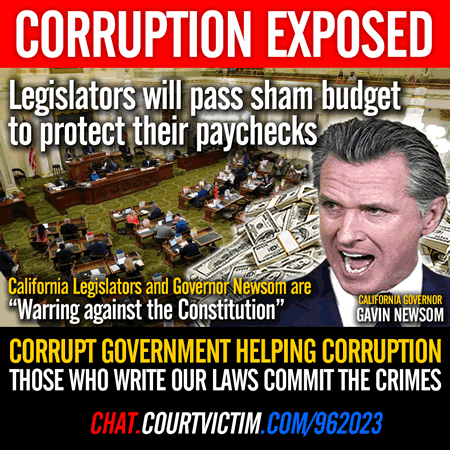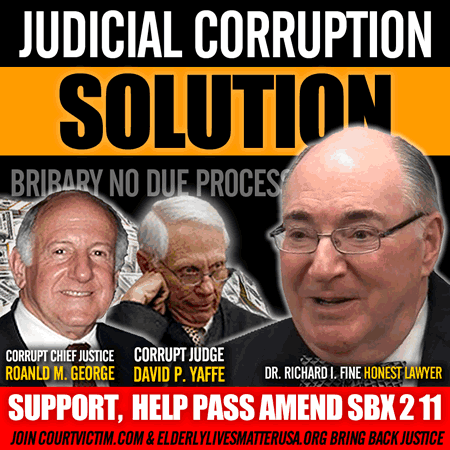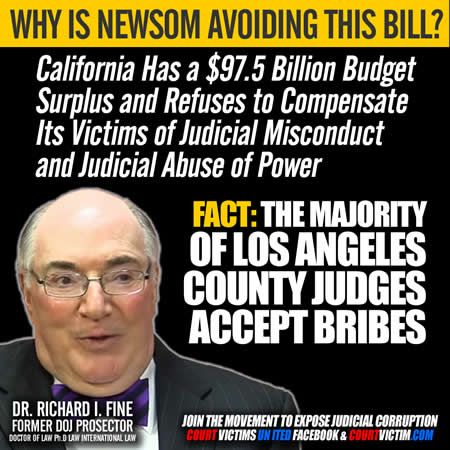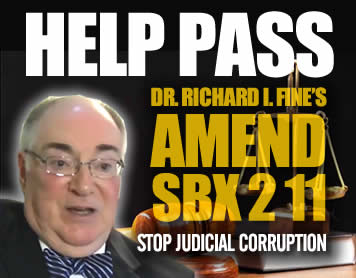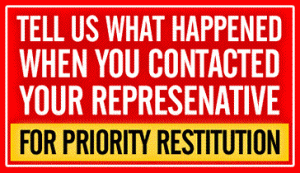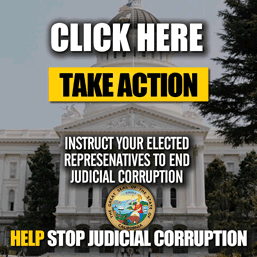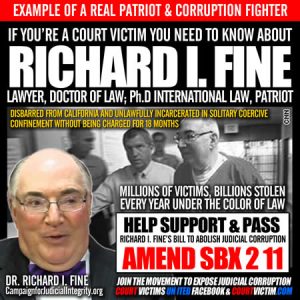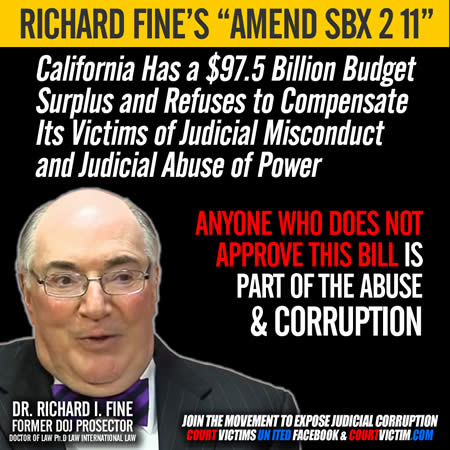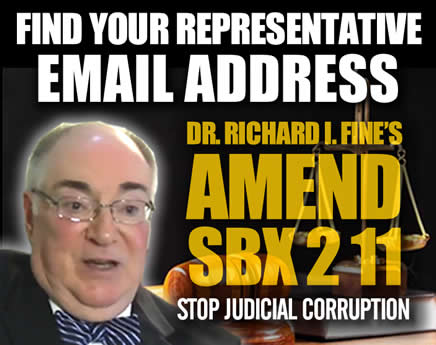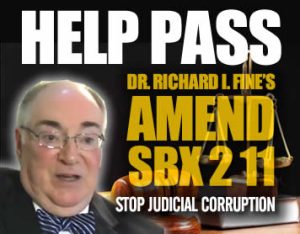
Introduction.
California is in a Judicial Corruption Crisis, and has been, since the mid to late 1980s when Los Angeles County began paying “supplemental or local judicial benefits” to California State Superior judges sitting on the California State Superior Court for the County of Los Angeles.
This crisis has been exasperated by the California Legislature’s failure to resolve the crisis despite the Court’s ruling it was the Legislature’s constitutional responsibility on two occasions in 2011 and 2015.
This 2022 California legislative session, the California Legislature was presented with: (1) a draft Bill Amending SBX 2 11 and related Government Code Sections; Establishing State of California Commission on Judicial Oversight and Victims Compensation for Judicial Misconduct and Judicial Abuse of Power; and (2) an immediate method to enact the Legislation by “Floor Amendment”.
The Legislature refused to act prior to the 2022 session ending on August 31, 2022.
This article will discuss: (1) The Historic Judicial Corruption Problem created by County and Court Payments to California State Superior Court Judges; (2) The Present State of California’s Judicial Corruption; (3) The Failure of the California Legislature to Resolve the Judicial Corruption Problem despite the Court’s Ruling on two Occasions in 2011 and 2015; (4) The Immediate Proposed Legislative Solution to the Judicial Corruption Problem; (5) An Immediate Method to Enact the Legislation by “Floor Amendment”; and (6) The Voters’ Solution if the Present Legislature Continues to Refuse to Enact the Immediate Solution in the Extended Legislative Session.
II. The Historic Corruption Problem created by County and Court Payments to California State Superior Court Judges.
Article VI, Section 19 of the California Constitution states in relevant part:
“The Legislature shall prescribe compensation for judges of courts of record.”
Commencing in the mid to late 1980’s, the County of Los Angeles (LA County) commenced paying California State Superior Court judges sitting on the California State Superior Court for the County of Los Angeles “supplemental or local judicial benefits” in addition to their compensation “prescribed” by the State Legislature pursuant to Article VI, Section 19 of the California Constitution.
These “supplemental or local judicial benefits” comprised annual: (1) “cafeteria plan” health benefits equal to those paid LA County employees; (2) professional development allowances; and (3) contributions to each judge’s 401K or 457 retirement plans. These “supplemental or local judicial benefits” amounted to approximately 29% of each Superior Court judge’s annual California State compensation.
By paying the “supplemental or local judicial benefits”, the members of the LA County Board of Supervisors increased their own compensation by approximately 29%, as Article II, Section 4 of the LA County Charter compensated the members of the LA County Board of Supervisors at the same compensation as the State of California Superior Court Judges.
Subsequently other California counties and Superior Courts followed LA County with their own “supplemental or local judicial benefits”.
These “supplemental or local judicial benefits” payments remained secret as they were concealed under other categories in the annual budgets of the counties.
On September 15, 2000, California Supreme Court Chief Justice Ronald M. George admitted the payments existed and called them “wrong and may be unconstitutional” in an annual meeting of the California Judges Association, which was reported in the Metropolitan News.
The author was the first person to expose the “supplemental or local judicial benefits” payments as unlawful in an appellate brief to the California Court of Appeals in 2000-2001. The exposure continued in subsequent court cases in which LA County was a defendant.
Subsequently, the case of Sturgeon v. County of Los Angeles, 167 Cal.App.4th 630, 635 (2008) Review Denied 12/23/2008 [Sturgeon I] held the “supplemental or local judicial benefits” payments unconstitutional stating in relevant part:
“Section 19, article VI of the California Constitution requires that the Legislature “prescribe compensation for judges of courts of record.” The duty to prescribe judicial compensation is not delegable. Thus, the practice of the County of Los Angeles (the county) of providing Los Angeles County superior court judges with employment benefits, in addition to the compensation prescribed by the Legislature, is not permissible.” (Emphasis added.)
In response to Sturgeon I, the California Legislature enacted SBX 2 11, 2/20/2009, effective 5/20/2009.
SBX 2 11 passed each chamber of the California Legislature by over a 2/3 vote, effectively “impeaching” and “convicting” the judges who received the county payments of “Misconduct in Office” under California Constitution, Article 4, Section 18, which provision required the judges’ removal from office.
California judges commit “Misconduct in Office” by taking “criminal” payments and violating their oath to uphold the U.S. and California Constitutions and laws each day they remain in office. Further, the judges committed fraud when taking the oath, without intending to perform the duties of upholding the Constitution and law.
SBX 2 11 did not order the removal of these judges from office. Section 2 of SBX 2 11 codified as Govt. Code 68220 (a) allowed the counties to keep paying the sitting judges the monies they paid them on July 1, 2008 “on the same terms and conditions as were in effect on that date.”
Section 2 of SBX 2 11 was held to be constitutional as an interim revenue measure in Sturgeon v. County of Los Angeles, 191 Cal.App.4th 344 (2011) [Sturgeon II] in which the Court affirmed Sturgeon I. The Court concluded that since judicial compensation is a state and not a county responsibility, it expected the Legislature to adopt a uniform statewide system of judicial compensation.
This did not occur. In Sturgeon v. County of Los Angeles, 242 Cal.App.4th 1437, 1450 (2015) [Sturgeon III], the Court extended the payments to all judges sitting in a court in which judges received county payments on July 1, 2008 stating in relevant part:
“The bottom line: Section 68220 subdivision (a) plainly requires any county paying its judges supplemental benefits as of July 1, 2008 to continue to pay its judges supplemental benefits, including all judges who took office after July 1, 2008—albeit subject to the right of the county in the first two sentences of subdivision (b) to terminate those benefits after specified notice. The county has no choice and no discretion to “fix” judicial compensation, which has thus been prescribed by the Legislature. The opt-out provisions of the first two sentences of subdivision (b) provide the only choice a county has in that situation, and even then, there’s no fixing of compensation, just a choice to pay the prescribed amount or not to pay any supplemental compensation at all. The last sentence of subdivision (b) is unconstitutional surplusage.” (Emphasis added.)
The Court in Sturgeon III again called for the Legislature to solve the problem and referenced the Daily Kos article Fine, End California’s Judicial Corruption Now; Stop 2015–16 Illegal Budget Payments to Judges! (June 1, 2015) < http://dailykos.com/story/2015/06/02/1389761/-End-California-s-Judicial-Corruption> [as of Aug. 25, 2015].)
SBX 2 11 Section 5, which was not codified into the Government Code gave the judges and the County supervisors retroactive immunity from criminal prosecution, civil liability and disciplinary action.
SBX 11, Section 5, stated in relevant part:
“SEC. 5. Notwithstanding any other law, no governmental entity, or officer or employee of a governmental entity, shall incur any liability or be subject to prosecution or disciplinary action because of benefits provided to a judge under the official action of a governmental entity prior to the effective date of this act on the ground that those benefits were not authorized under law.” (Emphasis added.)
Enacting Section 5 of SBX 2 11, the California Legislators and Governor each violated the federal criminal law of Misprision of Felony (18 U.S.C. Section 4) by concealing and not reporting the judges’ violation of the federal criminal law of the intangible right to honest services (18 U.S.C. Section 1346) and each violated his/her oath of office.
The U.S. Supreme Court held in Cooper v. Aaron, 358 U.S. 1, 18 (1958):
“No state legislator or executive or judicial officer can war against the Constitution without violating his undertaking to support it.” (Emphasis added.)
The U.S. judges knew of the California judges’ criminal activity through the enactment of SBX 2 11, its citation in briefs before them and because California judges were appointed to the U.S. District Courts in California and the 9th Circuit.
The U.S. judges through the U.S. Supreme Court violated constitutional precedent by refusing to disqualify the California judges from cases and violated the federal criminal law of Misprision of Felony by concealing the criminal acts and refusing to report the California judges for violating 18 U.S.C. Section 1346.
The U.S. judges’ actions protecting California’s judges destroyed U.S. constitutional rights to access to the courts, due process and a fair trial and the U.S. judicial system.
90% of California’s Approximate 1,600 Plus Superior Court Judges Received Unlawful Payments
A Report Prepared by the Administrative Office of the Courts, Judicial Council of California: Historical Analysis of Disparities in Judicial Benefits: Report to the Senate Committee on Budget and Fiscal Review, the Assembly Committee on Budget, and the Senate and Assembly Committees on Judiciary, (Dec. 15, 2009), Appendix D Supplemental Judicial Benefits in FY 2007-2008 showed approximately 90% of California’s approximate 1,600 Superior Court judges received supplemental benefits.
837 judges received supplemental benefits from 11 counties. 334 judges received supplemental benefits from counties and courts for a total of 1,129.
334 judges received supplemental benefits from only courts.
151 did not receive any supplemental benefits from 23 counties.
High cost of living counties which did not pay benefits were Marin and Santa Barbara counties.
Total statewide supplemental benefits paid were $33,602,542, with county supplemental benefits being $30,388,289 and court benefits being $3,214,253.
LA County [436 judges] was the highest county with $23,482,932. Orange County [112 judges] was second with $2,436,000. San Bernardino County [78 judges] was third with $1,280,175. Santa Clara County [79 judges] was fourth with $1,181,531. San Francisco County [51 judges] was fifth with $409,831. Riverside County [64 judges] was sixth with $401, 865.
San Diego Court [130 judges] was the highest court with $1,916,803.
By 2009, LA County had paid out over $400 million in unlawful “supplemental or local judicial benefits” and won literally 100% of the cases against it decided by a Superior Court judge as shown by the Litigation Reports of the County Counsel.
III. The Present State of California’s Judicial Corruption.
The California Supreme Court and Court of Appeal justices and Superior Court judges at all times knew, and know at present, 90% of California’s Superior Court judges sit on cases in which they are disqualified under law because the county which gave them a criminal payment: (1) appears before them as a party; (2) appears as a witness; or (3) has an interest.
Examples of the cases are: (1) child custody and family law cases; (2) class action cases; (3) conservator and elder cases; (4) constitutional cases; (5) contract cases; (6) criminal cases; (7) death, estate, and probate cases; (8) eminent domain cases; (9) environmental cases; (10) personal injury cases; (11) property cases; (12) regulation cases; (13) tax cases; (14) traffic cases; (15) trust cases; and (16) zoning cases, amongst others.
The California Supreme Court and Court of Appeal justices and Superior Court judges know: (1) that Section 5 of SBX 2 11 made California the most corrupt judicial system in the U.S., if not the world; (2) that California is the only state where a law gives judges immunity from criminal prosecution for taking illegal payments [bribes] from parties [counties] appearing before them in cases; (3) that they were perpetuating the corruption when they upheld unconstitutional and unlawful decisions affecting peoples’ rights by 90% of California’s Superior Court judges who unlawfully did not disclose their crimes or their legislative immunity to the litigants; (4) that they were perpetuating the corruption when they refused to require the DAs to prosecute the 90% of California’s Superior Court judges and recover the illegal payments from counties plus 20% penalty which the 90% of California’s Superior Court judges received after the effective date of SBX 2 11; (5) that they needlessly ruined peoples’ lives to perpetuate California’s judicial corruption; and (6) that their actions mandate their removal because they: (a) violated the U.S. and California Constitutions and laws; (b) engaged in “misconduct in office”; and (c) engaged in “conduct prejudicial to the administration of justice that brings the judicial office into disrepute”.
The U.S. and California Constitutions and laws are clear:
(1) U.S. Constitution, Article 6, Clause 2 states in relevant part:
“This Constitution, and the laws of the United States which shall be made in pursuance thereof; and all treaties made, or which shall be made, under the authority of the United States, shall be the supreme law of the land; and the judges in every state shall be bound thereby, anything in the Constitution or laws of any State to the contrary notwithstanding.” (Emphasis added.)
(2) California Constitution Article 4, Section 18 (d) states in relevant part: “State officers elected on a statewide basis, members of the State Board of Equalization, and judges of state courts are subject to impeachment for misconduct in office.” (Emphasis added.)
(3) California Constitution Article 6, Section 18 (d) (2) states in relevant part: “(d) Except as provided in subdivision (f), the Commission on Judicial Performance may …. (2) censure a judge or former judge or remove a judge for action occurring not more than 6 years prior to the commencement of the judge’s current term or of the former judge’s last term that constitutes willful misconduct in office, persistent failure or inability to perform the judge’s duties, ……. or conduct prejudicial to the administration of justice that brings the judicial office into disrepute”. (Emphasis added.)
(4) California Code of Civil Procedure Section 170.1(a)(6)(A)(iii) states in relevant part: “A judge shall be disqualified if any one or more of the following are true: A person aware of the facts might reasonably entertain a doubt that the judge would be able to be impartial.” (Emphasis added.)
(5) California Code of Judicial Ethics, Cannon 2 A states in relevant part: “A judge shall respect and comply with the law* and shall act at all times in a manner that promotes public confidence in the integrity* and impartiality* of the judiciary.” (Emphasis added.)
(6) California Code of Judicial Ethics, Cannon 3 E states: “(1) A judge shall disqualify himself or herself in any proceeding in which disqualification is required by law.*(2) In all trial court proceedings, a judge shall disclose on the record as follows: (a) Information relevant to disqualification A judge shall disclose information that is reasonably relevant to the question of disqualification under Code of Civil Procedure section 170.1, even if the judge believes there is no actual basis for disqualification.(b)Campaign contributions in trial court elections.” (Emphasis added.)
(7) California Code of Judicial Ethics, Cannon 4D(1) states in relevant part: “(1) A judge shall not engage in financial and business dealings that (a) may reasonably be perceived to exploit the judge’s judicial position, or (b) involve the judge in frequent transactions or continuing business relationships with lawyers or other persons likely to appear before the court on which the judge serves.” (Emphasis added.) and
(8) California Code of Judicial Ethics, Cannon 6A states in relevant part: “Anyone who is an officer of the state judicial system and who performs judicial functions, ….. is a judge within the meaning of this code. All judges shall comply with this code except as provided below.” (Emphasis added.)
None of the 90% of California’s Superior Court judges disclosed the illegal payments from the county, the retroactive immunity under Section 5 of SBX 2 11 and the current crime of taking the payments to litigants before them. The lawyers in the cases before such judges also concealed this information. Together, the 90% of California’s Superior Court judges and lawyers deprived the party before the judge of the opportunity to present evidence to obtain a fair trial before an unbiased judge.
This action of concealment is known as an “extrinsic fraud upon the court” and makes judgments void. California Code of Civil Procedure Section 473 (d) states in relevant part: “(d) The court ….. may, on motion of either party after notice to the other party, set aside any void judgment or order.”
Today, these illegal county payments to 90% of California’s Superior Court judges still occur at the rate of approximately $30 plus million a year and still are not being disclosed to the parties appearing before the judges.
Today the California Supreme Court and Court of Appeal justices are still perpetrating the corruption.
No California Supreme Court or Court of Appeal justice or Superior Court judge: (1) ended the corruption; (2) ordered the county payments to the 90% of California’s judges stopped knowing that it is illegal [a bribe] for a judge to take a payment from a party appearing in a case before him/her; or (3) required the DAs to prosecute the 90% of California’s judges and recover the illegal payments plus a 20% penalty as mandated under law both before and after the passage of Section 5 of SBX 2 11.
IV. The Failure of the California Legislature to Resolve the Judicial Corruption Problem despite the Court’s Ruling on two Occasions in 2011 and 2015
As shown above the Court in Sturgeon II and Sturgeon III concluded it was the sole duty of the Legislature to resolve the problem of the disparity in judicial compensation creating the judicial corruption.
The Legislature failed to act to this day.
V. The Immediate Proposed Legislative Solution to the Judicial Corruption Problem.
After years of urging Legislators to act through the website campaignforjudicialintegrity.org, the author drafted the Fine “Bill Amending SBX 2 11 and related Government Code Sections; Establishing State of California Commission on Judicial Oversight and Victims Compensation for Judicial Misconduct and Judicial Abuse of Power” (the Fine Legislation).
The Fine Legislation states in relevant part:
“THE PEOPLE OF THE STATE OF CALIFORNIA DO ENACT EMERGENCY LEGISLATION AS FOLLOWS:
SECTION 1: The Legislature finds and declares all of the following:
This legislation addresses and responds:
(1) to the systemic judicial crisis in California existing since approximately 1985 when individual counties and courts commenced paying State Superior Court judges sitting on State Superior Courts for their counties “supplemental or local judicial benefits” in addition to the State compensation (salary and benefits) paid to the judges by the State causing disparity in judges judicial salary and benefits, double taxation for citizens and residents in the “paying counties”, “unconstitutional (unlawful) ‘supplemental local judicial benefit payments’ ” to the judges resulting in 90% of California’s Superior Court judges receiving “bribes” under California and federal criminal laws;
(2) to President Biden’s June 3, 2021 Memorandum declaring Corruption to be a National Security Issue stating in relevant part:
“My Administration will lead efforts to promote good governance; bring transparency to the United States and global financial systems; prevent and combat corruption at home and abroad; and make it increasingly difficult for corrupt actors to shield their activities.” (Emphasis added.); and
(3) to the problem of judicial misconduct and judicial abuse of power in the judicial system by:
(a) equalizing judicial compensation to all California Superior Court judges;
(b) establishing a “compensation of victims of judicial misconduct and judicial abuse of power in the Judicial system” procedure outside the California Judicial system with predetermined dollar amounts to be paid directly to the individual “victims” by the State Controller; and
(c) establishing an administrative procedure outside the California Judicial system to rectify judicial misconduct and judicial abuse of power and institute oversight to prevent it from continuing or is reduced;
(4) to the failure of SBX 2 11 to establish any means of compensation to the individual victims of judicial misconduct and judicial abuse of power in the California Judicial system:
(a) while giving the perpetrators of unconstitutional payments to judges and the judges who received such payments in SBX 2 11, Section 5 retroactive immunity from civil liability, criminal prosecution and disciplinary action for all acts occurring prior to July 1, 2008;
(b) to the failure of SBX 2 11 to establish any means of compensation to the individual victims of judicial misconduct and abuse of power while allowing the “illegal payments” in Section 2;
(c) to the failure of SBX 2 11 to establish any means of compensation to the individual victims of “judicial officers” (including but not limited to temporary judges, commissioners, Superior Court judges, Court of Appeal justices and/or Supreme Court justices:
(i) who entered orders and judgments after deemed to have consented to their disqualification under CCP Section 170.3(c)(4);
(ii) who were disqualified under CCP Section 170.1 or 170.6; or
(iii) who failed to disclose information required under Code of Judicial Ethics, Canon 3E(2) and failed to disqualify themselves under Canon 3E(1);
(d) to the unlawful acts as exemplified by the egregious, examples of judicial misconduct and judicial abuse of power upon the following individuals:
(i) Richard Lee Abrams;
(ii) Stanley Atkinson;
(iii) Stephan Brooks:
(iv) Ryan Clifford:
(v) Richard Isaac Fine:
(vi) Gertrude Gettinger;
(vii) Robert George Kincaid;
(viii) Georges Marciano;
(ix) Carol Pulliam; and
(x) Felice Reyes;
(5) The actions taken by the California Judiciary against victims of judicial misconduct and judicial abuse of power (as exemplified herein by actions taken against Richard Isaac Fine) violated Article 1, Sections 1, 2, 3, 7, 17 and 26 of the California Constitution;
(6) The actions taken by the California Judiciary against victims of judicial misconduct and judicial abuse of power (as exemplified herein by actions taken against Richard Isaac Fine) violated:
(a) United States Constitution, Fourteenth Amendment, denial of due process and equal protection; Cooper v. Aaron, 358 U.S. 1, 18 (1958)-“No state legislator or executive or judicial officer can war against the Constitution without violating his undertaking to support it.” (Emphasis added.);
(b) California Constitution, Article 4, Section 18 (b) “misconduct in office” by engaging in conduct which punished lawyers for following their oath to uphold the Constitution and laws of the United States and the State of California; and
(c) California Constitution, Article 6, Section 14 – “Decisions of the Supreme Court and courts of appeal that determine causes shall be in writing with reasons stated.” by deciding motions affecting the jurisdiction of the court without reasons stated;
(7) The individual victims of judicial misconduct and judicial abuse of power cannot obtain relief from the actions taken against them by the California Judiciary as no relief is available under either California or federal law due to either:
(a) lack of jurisdiction;
(b) absolute judicial immunity;
(c) the Eleventh Amendment; and/or
(d) bias of the judiciary;
(8) The only relief available to the individual victims of judicial misconduct and judicial abuse of power is through action of the Legislature and the Governor by amending SBX 2 11;
(9) The emergency nature of this problem requiring immediate passage of this legislation and
(10) It is imperative the Legislature and the Governor uphold the United States and California Constitutions, the integrity of the judicial system and underscore the commitment to never allow those who pursue the goals of such ever be punished for such pursuit.
SECTION 2. The following is added to the laws of the State of California:
(1) amending SBX 2 11 by repealing Section 2 (which added Section 68220 to the Government Code), Section 3 (which added Section 68221 to the Government Code), and Section 4 (which added Section 68222 to the Government Code) to create a uniform pay schedule for California Superior Court judges;
(2) repealing Sections 68220, 68221 and 68222 of the Government Code;
(3) amending SBX 2 11 by adding Section 8 establishing payments to the individual victims of the unlawful payments to State Superior Court judges by counties and courts, Court of Appeal Justices, and California Supreme Court Justices who received such while they were State Superior Court judges to be made by the State Controller from the annual funds budgeted to the State Court System;
(4) amending SBX 2 11 by adding Section 9 establishing payments to individual victims of judicial officers (Commissioners, Temporary Judges, Superior Court Judges, Court of Appeal Justices State Supreme Court Justices):
(a) who entered orders and judgments after deemed to have consented to their disqualification under CCP Section 170.3(c)(4);
(b) who were disqualified under CCP Sections 170.1 and/or 170.6; or
(c) who failed to disclose information required under Code of Judicial Ethics, Canon 3E(2) and failed to disqualify themselves under Canon 3E(1);
(5) amending SBX 2 11 by adding Section 10 which establishes payments to be made to the individuals claiming from January 1, 1985 onwards as victims of judicial misconduct and judicial abuse of power in Sections 8 and 9 by the California State Controller commencing from the effective date of this legislation from monies annually allocated to the Judicial Branch of the California State Government with a minimum of $100 million per year annually diverted to the California State Controller to establish and pay for an independent State of California Permanent Commission on Judicial Oversight and Victim Compensation for Judicial Misconduct and Judicial Abuse of Power (Commission):
(a) composed of twelve (12) voting members (four (4) current elected officials or their designees while current, seven (7) citizen advocates and a Chair Person):
(i) who are not, or were not members of, or employed by, the Judicial Branch of the California State Government;
(ii) to be individually paid under the State of California system at the rate of compensation equal to the compensation for the Governor of the State of California;
(iii) serving up to four year terms, but no greater than eight (8) years total, being:
(aa) the then current Governor of California (serving without extra compensation) or his/her designee (serving with compensation), representing the Executive Branch of the California State Government;
(bb) the then current State Controller of California (serving without extra compensation) or his/her designee (serving with compensation), representing the Executive Branch of the California State Government;
(cc) the then current President Pro Tem of the California State Senate (serving without extra compensation) or his/her designee (serving with compensation), representing the Legislative Branch of the California State Government;
(dd) the then current Speaker of the California State Assembly (serving without extra compensation) or his/her designee (serving with compensation); representing the Legislative Branch of the California State Government;
(ee) to be determined, and successor citizen advocates for civil court reform, representing the citizens of California, for initial term of up to four (4) years;
(ff) to be determined, and successor citizen advocates for criminal court reform, representing the citizens of California for an initial term of up to four (4) years;
(gg) to be determined, and successor citizen advocates for family court reform, representing the citizens of California for an initial term of up to four (4) years;
(hh) to be determined, and successor citizen advocates for juvenile court reform, representing the citizens of California for an initial term of up to four (4) years;
(ii) Robert Gettinger, and successor citizen advocates for probate court reform, representing the citizens of California for an initial term of up to four (4) years;
(jj) to be determined, and successor citizen advocates for appellate court and/or supreme court reform, representing the citizens of California for an initial term of up to four (4) years;
(kk) to be determined, and successor citizen advocates for civil, elder, human, individual, property, taxpayer, tenants, veteran’s rights and/or other rights reform, representing the citizens of California for an initial term of up to four (4) years; and
(ll) Richard Isaac Fine, Doctor of Law, Ph.D. (the California lawyer who first exposed and brought the first lawsuit against the unlawful “county payments to Superior Court judges”, the creator of this legislation, and the author of the Daily Kos article recognized in Sturgeon v. County of Los Angeles, supra, 242 Cal.App.4th at 1450 FN. 12 recognizing “groups as diverse as Judicial Watch and the Daily Kos continue to inveigh against county payments to judges.”) as Chair Person and his successor citizen advocates for judicial integrity and judicial ethical reform, for an initial and a successive term, each of four (4) years; appointing initial and successor citizen advocates for the following categories:
(1) civil court reform;
(2) criminal court reform;
(3) family court reform;
(4) juvenile court reform;
(5) probate court reform;
(6) appellate and/or supreme court reform; and
(7) civil, human, individual, property, taxpayer, tenants, veterans’ and/or other rights reform;
(b) with the Commission’s employees paid under the State of California compensation system;
(c) with the following duties are amongst others:
(i) to oversee the Judicial Branch of the State of California Government;
(ii) to directly compensate the victims of judicial misconduct and judicial abuse of power through the State Controller;
(iii) to ensure the State Controller completes the requirement to report the offending Judicial Officers to the Commission on Judicial Performance on a monthly and annual basis;
(iv) to ensure the Commission on Judicial Performance completes the requirement to complete each investigation reported to it by the State Controller within six months after receipt of such Report and convey semi-annual Reports of the results of such investigations to the California State Auditor;
(v) to ensure the California State Auditor:
(aa) continuously audits the Commission on Judicial Performance to ensure the Commission on Judicial Performance is fully investigating, reviewing and making determinations as required under law on each Judicial Officer’s individual and historical misconduct as reported both by the California State Controller and independently from other sources;
(bb) makes annual reports to the State Senate and State Assembly as to the conduct of the Commission on Judicial Performance in conducting its duties including but not limited to its successes, failures, and operational deficiencies regarding the misconduct of the Judicial Officers; and
(cc) makes recommendations for legislation to improve the operation of the Commission on Judicial Performance to reduce the misconduct and abuse of power of the judiciary, including but not limited to the Office of the Chief Trial Counsel of the State Bar of California and the State Bar Court;
(vi) to enforce the thirty six (36) year individual judicial term limit; and
(vii) to perform such other acts as necessary to administer and enforce this legislation commencing upon the effective date of this legislation; under funding of $100 million annually or more provided each year through the Annual State Budget or an amendment thereto through a trailer bill for the 2021-2022 Annual State Budget and within the consecutive Annual Budgets thereafter; from monies annually allocated to the Judicial Branch of the California State Government as follows:
(aa) $1 million tax free per year for each year from January 1, 1985 onwards for defamation (including libel) caused by judicial misconduct or judicial abuse of power which existed or continues to exist;
(bb) $10 million tax free per year for each year from January 1, 1985 onwards for unlawful incarceration caused by judicial misconduct or judicial abuse of power which existed or continues to exist;
(cc) $10 million tax free for fraud upon the court caused by judicial misconduct or judicial abuse of power from January 1, 1985 onwards;
(dd) $10 million tax free for fraud caused by caused by judicial misconduct or judicial abuse of power from January 1, 1985 onwards;
(ee) $10 million tax free for intentional interference with contract caused by judicial misconduct or judicial abuse of power from January 1, 1985 onwards;
(ff) $10 million tax free for negligent interference with contract caused by judicial misconduct or judicial abuse of power from January 1, 1985 onwards;
(gg) $10 million tax free for intentional interference with prospective business advantage caused by judicial misconduct or judicial abuse of power from January 1, 1985 onwards;
(hh) $10 million tax free for negligent interference with prospective business advantage caused by judicial misconduct or judicial abuse of power from January 1, 1985 onwards;
(ii) $10 million tax free for intentional infliction of emotional distress caused by judicial misconduct or judicial abuse of power from January 1, 1985 onwards;
(jj) $10 million tax free for negligent infliction of emotional distress caused by judicial misconduct or judicial abuse of power from January 1, 1985 onwards;
(kk) $10 million tax free for bias against self-represented litigants from January 1, 1985 onwards;
(ll) $10 million tax free for bias against litigants with physical or mental disabilities from January 1, 1985 onwards;
(mm) $10 million tax free for abuse against litigants over 65 years old (elder abuse) from January 1, 1985 onwards;
(nn) $10 million tax free for any other cause of action not mentioned above caused by judicial misconduct or judicial abuse of power from January 1, 1985 onwards;
(oo) $10 million tax free for any other unmentioned misconduct or abuse of power by the “Judicial Officer” (Commissioners, Temporary Judges, Superior Court Judges, Court of Appeal Justices and/or State Supreme Court Justices) from January 1, 1985 onwards; and
(pp) additionally for attorneys who brought cases against counties or the courts of the State of California from January 1, 1985 onwards:
(1) one third (33.33%) of damages alleged or shown in any case prior to trial dismissed by a Superior Court judge who received “supplemental or local judicial benefits” or other unlawful payment;
(2) forty percent (40%) for any case settled or dismissed prior to trial; and
(3) one half (50%) of damages awarded at trial and/or then denied or overturned by the California Supreme Court, any panel of a State Court of Appeal or Appellate Division of a Superior Court upon which a justice or judge who violated or is violating paragraph (2)(a)-(c) above was or is a member; and
(6) amending SBX 2 11 by adding Sections 11-25 to directly compensate the following individual victims as egregious examples and representatives of the various categories of judicial misconduct and abuse of power upon which the California State Controller may rely as precedents for his/her awards:
(a) Stanley Atkinson, Richard Lee Abrams, Stephan Brooks, Richard Isaac Fine, Gertrude Gettinger, Robert George Kincaid and Carol Pulliam for the category allowing County or court payments to judges to negatively control judicial decisions;
(b) Richard Lee Abrams, Georges Marciano and Carol Pulliam for the category of antisemitism and bias against religion, race, gender or sexuality to negatively control judicial decisions;
(c) Stanley Atkinson, Stephan Brooks, Ryan Clifford, Felice Reyes and Robert George Kincaid for the category allowing status of representation, such as self- representation before the court to negatively control judicial decisions;
(d) Ryan Clifford for the category allowing the litigant’s physical or mental disability to negatively control judicial decisions;
(e) Stanley Atkinson, Richard Isaac Fine and Gertrude Gettinger for the category allowing the age of the litigant being 65 years or older (Elder Abuse) to negatively control judicial decisions;
(f) Richard Isaac Fine, Doctor of Law; Ph.D. Law (International Law) for the category of judicial and/or political retaliation by “Judicial Officers” and their “Associates and Affiliates in the Judicial Branch” (such as the State Bar of California or California State Bar, of which five of its thirteen of its Board of Governors is selected by the California Supreme Court and seven of its thirteen members are members of the State Bar of California, the Office of the Chief Trial Counsel of the State Bar of California and the State Bar Court) against lawyers and others who expose and/or challenge judicial misconduct and abuse of power, in particular:
*****
(g) Richard Lee Abrams, Stanley Atkinson, Stephan Brooks, Richard Isaac Fine, Gertrude Gettinger, Robert George Kincaid, Georges Marciano, Carol Pulliam and Felice Reyes for the category of judges who were disqualified under law and did not leave the case to negatively control judicial decisions; and
(h) Richard Lee Abrams, Stanley Atkinson, Stephan Brooks, Ryan Clifford, Richard Isaac Fine, Gertrude Gettinger, Robert George Kincaid, Georges Marciano, Carol Pulliam and Felice Reyes for the category of a combination of any of the above or other unlawful factors to negatively control judicial decisions;
****
(21) establishing an administrative procedure outside the court system to ensure judicial misconduct and abuse of power does not continue or is reduced as follows:
(a) amending SBX 2 11 by adding Section 25 requiring the California Controller to report all Judicial Officers who were reported by victims of judicial misconduct or abuse of power to the Commission on Judicial Performance on a monthly and annual basis, annually funded under this legislation;
(b) amending SBX 2 11 by adding Section 26 requiring the Commission on Judicial Performance to complete each investigation reported to it by the California State Controller within six months after receipt of such Report and convey semi-annual Reports the results of such investigations to the California State Auditor; and
(a) amending SBX 2 11 by adding Section 27 requiring the California State Auditor:
(i) to continuously audit the Commission on Judicial Performance to ensure the Commission on Judicial Performance is fully investigating, reviewing and making determinations as required under law on each Judicial Officer’s individual and historical misconduct as reported both by the California State Controller and independently from other sources; and
(ii) make annual reports to the State Senate and State Assembly as to the conduct of the Commission on Judicial Performance in conducting its duties including but not limited to its successes, failures, and operational deficiencies regarding the misconduct of the Judicial Officers and recommendations for legislation to improve the operation of the Commission on Judicial Performance to reduce the misconduct and abuse of power of the judiciary, including but not limited to the Office of the Chief Trial Counsel of the State Bar of California and the State Bar Court; and
(b) amending SBX 2 11 by adding Section 28 to establish a thirty six (36) year term limit on the members of the judiciary who received retroactive immunity from civil liability, criminal prosecution and disciplinary action under SBX 2 11, Section 5, thereby allowing any criminal action under 18 U.S.C. Section 1346 to continue unabated with those judicial officers and allowing both state and federal criminal actions to be brought against any subsequently appointed or elected judicial officers receiving “supplemental or local judicial benefits” from counties or courts. “
VI. An Immediate Method to Enact the Fine Legislation by “Floor Amendment”.
A copy of the Fine Legislation was emailed to the personal emails of all 40 current California State Senators and 80 California State Assembly Members requesting their sponsorship of the Fine Legislation.
This was followed by phone calls to the offices of those State Senators and State Assembly Members who responded to the emails requesting an email to their general office email.
Additionally, personal contact was made with certain legislators prior to the mass email contact.
The emails showed each recipient how they could use the method of a “Floor Amendment” to amend a present Assembly Bill 2960 entitled “Judiciary Omnibus”, which encompassed the subject matter of the Fine Legislation and immediately pass the Fine Legislation to Governor Newsom for his signature.
Using this recognized method, the Fine Legislation would be enacted during the 2022 Legislative Session ending August 31, 2022 and prior to the November General Election when all 80 State Assembly Member positions are open for election and 20 of the 40 State Senator positions are open for election.
The Legislators did not act prior to August 31, 2022.
VII. The Voters’ Solution if the Present Post Session of the Legislature Refuses to Enact the Immediate Solution.
In the event the present post August 31, 2022 session of the Legislature or a present legislator refuses to enact or vote for the Fine Legislation, the Voters’ Solution is as follows:
(1) Refuse to donate to, and suggest all others to refuse to donate to, the election campaign of any incumbent State Legislator who refused to sponsor or vote for the Fine Legislation;
(2) Request all non-incumbent candidates for any Legislative position sign a written pledge, if elected they will sponsor, vote for and pass the Fine Legislation;
(3) approach all individual donors to campaigns to do the same and encourage their friends and associates to do the same; and
(4) contact all PACs and institutional donors and request they also so the same.
Conclusion
At present, California has a $97.5 billion budget surplus, the largest in California history. Yet the Legislature has refused to compensate the victims of Judicial Misconduct and Judicial Abuse of Power.
The judiciary is the third institution of government and directly affects each of our freedoms and rights.
We, individually and as a society cannot survive if it the institution of the Judiciary and/or its individual members remain corrupt.
Richard I. Fine; Doctor of Law (The Law School; Univ. of Chicago); Ph.D. – Law (International Law) (the London School of Economics & Political Science; Univ. of London); Chmn., Campaign for Judicial Integrity; Co-Chmn., Judicial Reform Committee, DivorceCorp.


Find out who your state representatives are
GO TO: Find Your Rep.legislature.ca.gov/
1. Enter your address
2. Use the “Contact form” on your representatives website
3. Select “Other”
4. Copy and enter the following in the box on your representative’s contact form
Click Copy to Clipboard Below:
Dear representative: California has the most corrupt judicial system in the nation. At present, approximately 90% of the California Superior Court judges receive the illegal payments from counties or courts, and most of the higher court justices received such when they were Superior Court judges.
I demand YOU sponsor and support the Dr. Richard I. Fine Bill “Amending SBX2 11 and Related Government Code Sections; Establishing a State of California Commission on Judicial Oversight and Victims Compensation for Judicial Misconduct and Judicial Abuse of Power”. Passing the “Fine Bill” solves the “Corruption Problem”.
The reason is: In 2010, the Court held the Legislature was responsible to permanently resolve the problem created by the enactment of SBX 2 11. The Court held SBX 2 11 was interim legislation. SBX 2 11 was enacted in response to the Court holding “supplemental or local judicial benefits” paid to California State Superior Court judges by counties and/or courts was unconstitutional under California Constitution Article 6, Section 19. The payments were and under SBX 2 11 also are criminal under California and federal law. A 2009 Judicial Council Report to the Legislature showed as of 2008, 90% of the California Superior Court judges received the illegal payments. A copy of “Amend SBX 2 11” is located at: https://courtvictim.com/justicebill
Dear representative: California has the most corrupt judicial system in the nation. At present, approximately 90% of the California Superior Court judges receive the illegal payments from counties or courts, and most of the higher court justices received such when they were Superior Court judges.
I demand YOU sponsor and support the Dr. Richard I. Fine Bill "Amending SBX2 11 and Related Government Code Sections; Establishing a State of California Commission on Judicial Oversight and Victims Compensation for Judicial Misconduct and Judicial Abuse of Power”. Passing the “Fine Bill” solves the "Corruption Problem”.
The reason is: In 2010, the Court held the Legislature was responsible to permanently resolve the problem created by the enactment of SBX 2 11. The Court held SBX 2 11 was interim legislation. SBX 2 11 was enacted in response to the Court holding “supplemental or local judicial benefits” paid to California State Superior Court judges by counties and/or courts was unconstitutional under California Constitution Article 6, Section 19. The payments were and under SBX 2 11 also are criminal under California and federal law. A 2009 Judicial Council Report to the Legislature showed as of 2008, 90% of the California Superior Court judges received the illegal payments. A copy of "Amend SBX 2 11" is located at: https://courtvictim.com/justicebill
GET PRIORITY AND TAKE ADVANTAGE OF THE BILL BY SHOWING YOU HELPED:
Take a photo or screen shot of your submission to your representative’s and keep it where you can refer to it at a later time.
The reason for this is the creators of the bill want to reward those who supported it and helped get it passed. Those victims will be allowed to file for restitution first and will need
to supply proof they’ve done so. Click on the button below to send your snapshot and info:

A copy of the Bill can be found HERE
Richard I. Fine drafted the bill
FAQ (Frequently Asked Questions)
1. Am I a candidate to get restitution via this Bill?
YES if you’ve been victimized by a California Judge.
2. Does this apply to victims going back how many years?
To the mid 1980’s
3. Besides restitution for my abuse what else does the Bill do to stop Judicial abuse?
A Commission is established to oversee the judiciary
4. What will stop the deep corruption from using the court system once again to ignore the bill or change it once implemented?
The Commission functions to stop all judicial corruption
5. Who is Richard I. Fine?
Richard I. Fine, (Doctor of Law; Ph.D Law-International Law). He is a patriot and lawyer (presently qualified to practice before the United States Supreme Court). He was disbarred from California and “unlawfully incarcerated in solitary coercive confinement without charges being made” for 18 months in the Los Angeles County jail in retaliation for exposing (Dishonorable) Judge David Paul Yafee #29399 and all of the Los Angeles County Superior court judges for accepting unlawful payments/bribes from the county. These payments resulted in literally no one winning a case against the county when a judge made the decision.
Dr. Richard I. Fine FULL BIO
[kaya_qrcode title=”How to Contact Your CA Legislator to Pass “Dr. Richard I. Fine Bill” to End Judicial Corruption” title_align=”alignnone” ecclevel=”L” align=”alignnone”]
MORE
MORE INFO ABOUT RICHARD I. FINE’S EXPERIENCE
INFO ABOUT RICHARD I. FINE’S CAMPAIGN FOR JUDICIAL INTEGRITY

MORE ON DR. RICHARD I. FINE AND AMEND SBX 2 11

[subpages]

